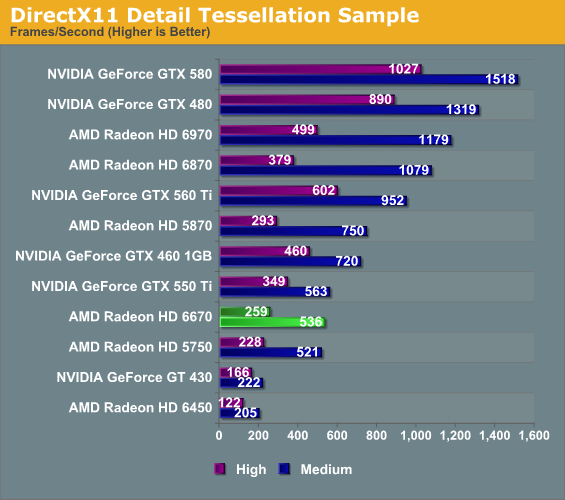AMD’s Radeon HD 6670 & Radeon HD 6570: Two’s Company, Sub-$100’s A Crowd
by Ryan Smith on April 19, 2011 12:01 AM ESTCompute & Tessellation Performance
Our first compute benchmark comes from Civilization V, which uses DirectCompute to decompress textures on the fly. Civ V includes a sub-benchmark that exclusively tests the speed of their texture decompression algorithm by repeatedly decompressing the textures required for one of the game’s leader scenes. Note that this is a DX11 benchmark.

While Turks and the 6670/6570 are quite a bit faster than the 6450, both are still so-so as compute cards. Although the unit of measurement (fps) is effectively arbitrary, what isn’t arbitrary is that the 5750 is nearly 33% ahead of the 6670. Juniper (5750/5770) seems to be the floor for good compute performance on AMD cards.
Our second compute benchmark of the day is SmallLuxGPU, the GPU ray tracing branch of the open source LuxRender renderer. While it’s still in beta, SmallLuxGPU recently hit a milestone by implementing a complete ray tracing engine in OpenCL, allowing them to fully offload the process to the GPU. It’s this ray tracing engine we’re testing. AMD in turn recently hit a milestone by offering the OpenCL runtime with their drivers, so SmallLuxGPU will now run out of the box without the AMD Compute SDK.

At 3200K rays/sec, the 6670 actually beats the Radeon HD 4870 by about 10%, showcasing just how far AMD’s compute performance has come compared to the 4000 series. The 6670 also enjoys a similar lead over the 5670 thanks to its additional shaders, but the 720SP 5750 looms large above it.
At the other end of the spectrum from GPU computing performance is GPU tessellation performance, used exclusively for graphical purposes. Barts’ tessellation improvements are inherited by Turks, which should give it an edge over the 5670.

What ended up surprising us the most with our DX11 Detail Tessellation Sample test wasn’t so much the raw performance of the 6670, it was the performance relative to some other AMD cards. At a high tessellation factor the Radeon HD 5870 isn’t all that far ahead, and meanwhile the 5750 is edged out by the 6670 in all cases. Given that our most tessellation-intensive games struggled at 1680x1050 on the 6670 it may not be powerful enough to really use its tessellation abilities in full on top of a heavy graphical workload, but the basis for respectable tessellation performance is there.










53 Comments
View All Comments
codedivine - Tuesday, April 19, 2011 - link
Just a clarification:. I guess these don't support fp64?Ryan Smith - Tuesday, April 19, 2011 - link
Correct. AMD only supports FP64 on the 5800, 5900, and 6900 series.haplo602 - Tuesday, April 19, 2011 - link
6800 do not ?Ryan Smith - Tuesday, April 19, 2011 - link
Also correct. The 6800 series (Barts) does not support FP64; AMD opted not to include it to save on die space.haplo602 - Tuesday, April 19, 2011 - link
awww so my choices got reduced to the 5850 :-(Taft12 - Tuesday, April 19, 2011 - link
At $150, 5850 is the obvious choice anyway (today - 6570/6670 launch day)http://www.newegg.com/Product/Product.aspx?Item=N8...
Macabre215 - Tuesday, April 19, 2011 - link
Eh. If this is your price point you might as well go with a 5670.Taft12 - Tuesday, April 19, 2011 - link
Not if you want the 6xxx-series features.OzzieGT - Saturday, April 23, 2011 - link
Why? 5670 costs only $5 less on newegg right now and it uses more power. I would rather pay the extra $5 for the newest generation card if it offers the same performance.dagamer34 - Tuesday, April 19, 2011 - link
Don't these cards do AMD 3D? That's the only reason for someone to upgrade a previous HTPC card to something with a Turks GPU.